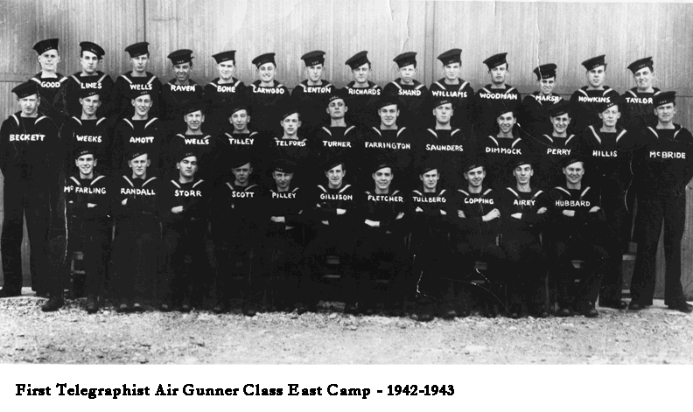
Remembering the Telegraphist Air Gunners

Yarmouth - Wartime History
RCAF Station Yarmouth
EAST CAMP 1942-1946
Telegraphist Air Gunners
(From the Air to Destroy the Beast)
(photo courtesy Yarmouth County Museum and Archives)
East Camp was a part of the World War II RCAF
Station, Yarmouth, Nova Scotia. The Camp was located
on a twenty acre area of the airport with a main
entrance from the Chebogue Road in the Arcadia area of
Yarmouth County
The Camp included forty buildings,including
aircraft hangars, messes, and quarters for the men. The
building were arranged on a sloping hill upward to the
hangars and main runways.
Construction
•
Construction began in 1941 by an Ontario construction Company using local men
•
British Columbian fir were used to construct the hangars
•
Messes and quarters were built from wood cut and milled in south western Nova Scotia.
•
Metal parts used in the construction were machined at the Hebron Shoe Factory
•
Approximately ten teams of carpenters, consisting of fifteen to twenty men with a foreman.
•
Local carpenters were used from Yarmouth, Wedgeport, Carleton, Port Maitland, and the Work was carried out on one building
at a time until completed
Construction Salaries
.35/hr labourers
.55/hr for carpenters
.75/hr for foreman
Water
•
When first occupied there was no running water
•
First attempts at drilling were unsuccessful
•
Eventually water was found below 300 feet.
•
Three wells drilled in total to supply the entire base.
•
When first occupied East Camp trainees used the facilities at West Camp and carried water from there to East Camp.
Heating
•
A problem in the first year of operation
•
Buildings were too far apart
East Camp was home to:
# 34 OTU (Operational Training Unit) Royal Air Force (1942)
The Camp was used as a temporary training base until the unit moved to Pennfield Ridge, New Brunswick in the spring of 1942.
# 1 Naval Air Gunnery School - Royal Navy (1942-1945)
The base was used for training Telegraphist Air Gunners, Fleet Air Arm, Royal Navy as part of the British Commonwealth Air
Training Plan.
It was a unique multi-service school with both ground and air training by the Royal Navy and administration by the Royal
Canadian Air Force.
The main base for Telegraphist Air Gunners was located at Worthy Downs, Portsmouth, England. British recruits in England were
divided into two groups fifty percent to be trained in Yarmouth, Nova Scotia and the second fifty percent trained at Worthy Downs.
Ground school and in-flight training took about ten months. Ground training was supervised by Royal Navy Petty Officers in the
School Training Centre.
The TAGs received training in
•
Morse code
•
Radio Operations
•
Discipline
•
Gunnery
•
Naval regulations
•
Flight Experience
In-flight air experience included proper sending and receiving communication techniques and air gunnery training while flying
as crew in Fairey Swordfish and Avro Anson aircraft. The pilots were from the Royal Navy Fleet Air Arm, RCAF, RNZNVR and the
RNZAF.
The goal of training was to produce air gunners for use on British aircraft carriers.
Trained in wireless communication and gunnery, their role was to maintain communication between planes and ships and to act
as rear gunners on various types of aircraft. Having learned proficiency in Morse code, wireless theory, gunnery, and procedures to
communicate with other airborne aircraft and with the fleet, the TAGs served on carrier ships in both the Atlantic and Pacific and
participated in many of the important campaigns during World War II.
The first group of TAGs (Course 45A) arrived in Yarmouth on Christmas Eve, 1942. (All Class Photos)
Camp Administration was under the command of the RCAF and included hospital services, motor transport, general reports,
security, payroll, supplies and food.
East Camp, Yarmouth, and the Telegraphist Air Gunners
Aside from the training East Camp becomes the host of many
social activities, dinners, dances, and opportunities to socialize with
the people of Yarmouth.
Many socials are also held in Yarmouth. The YMCA and local
churches put on dances and friendly get-togethers between the people
of Yarmouth and the men at East Camp.
Sports
Sports became an important part of life at East Camp. The
servicemen played soccer and baseball in summer. A large work
party soon cleared a large playing field on the base and East Camp
put on 'Sports Days' with a variety of competition activities
between the men including races and tugs of war.
Competitive sports was also carried on between Cornwallis
and East Camp.
The East Camp trainees had many off base activities that
included hockey, skating, baseball, boating, and golf.
Winter indoor sports were played on base to pass the free
time in winter months.
East Camp rented Braemar Lodge, located outside of Yarmouth on Braemar Lake for summer activities to provide a location
away from the base for relaxation from training.
Canteens
Canteens were added to the base to save trainees
the journey into town. However, despite the .25 fare
many continued to go into Yarmouth.
Romance
Many romances between East Camp trainees and the Yarmouth town girls. There were more than twenty marriages following
the war.
Aircraft and Training Experiences
East and West Camps at RCAF Station Yarmouth experienced a number of aircraft and training accidents.
Not all accidents were fatal for the crews. In one instance a Ventura aircraft ended up with extensive damage to it belly when
the pilot ran over a wheelbarrow on the runway. In another a Lysander crashed into Barrio Lake.
On one training mission a Telegraphist Air Gunner shot through the wings of a swordfish forcing the pilot to make an emergency
landing.
A Ventura aircraft did crash during a supply flight and the crew was
killed in the incident and a mid-air crash between two Swordfish resulted in
the death of four TAGs
After a period of routine training, the number of swordfish accidents
began to increase. Unofficially, the reason was bored pilots who began to
attempt low flying manoeuvres or dog fights over Digby. This ended when the
base commander stepped in. Rumours that Lake Rossignal was being used as a
landing strip during the winter ended after an Anson landed there breaking off
the prop tips.
Winter flying in open swordfish was extremely cold and the cockpits
were eventually closed in for winter use.
Dress Parades
Dress parades were common at East Camp and included regular base inspections, parades into town, Victory bond parades and
November 11th Ceremonies.
Many TAGs relaxed at the homes of Yarmouth
people while others pursued female acquaintances.
Others spent time at the YMCA, Milo Boat Club, Braemar
or the Snackerie in Dayton, just outside of Yarmouth.
Telegraphist Air Gunners (TAGS) operated in Royal Navy Fleet Air Arm aircraft from 1922. The very last TAG served until 1950.
3,000 TAGS were trained over a 28 year life span. 495 were lost through enemy action and/or flying accidents and 69 became
Prisoners of War. Most TAGS served only for the period of WW2 returning to their civilian occupations in 1945 and 1946.
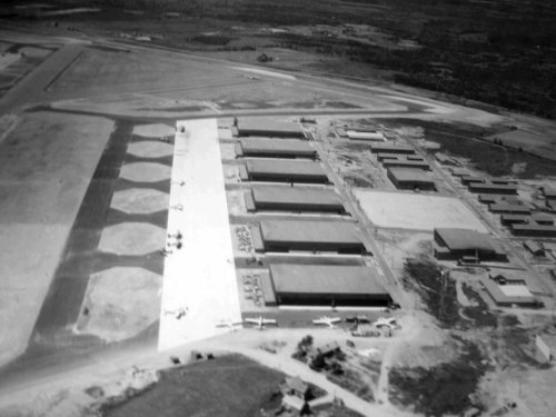
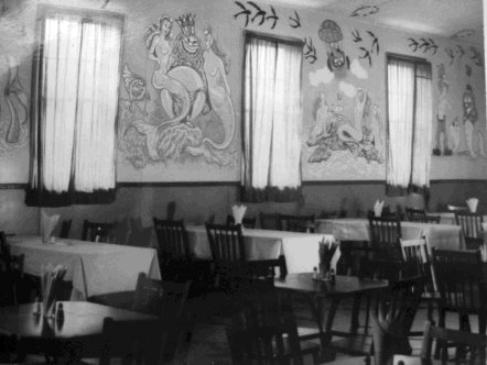
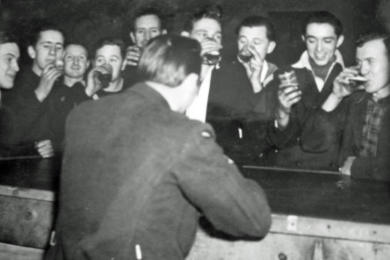
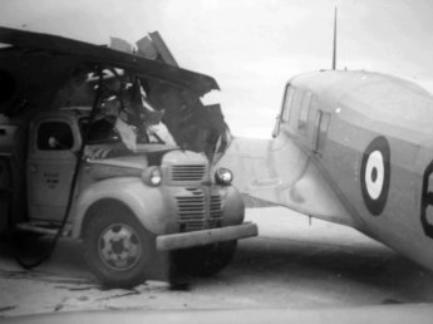
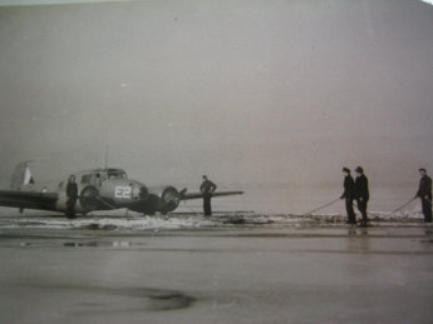

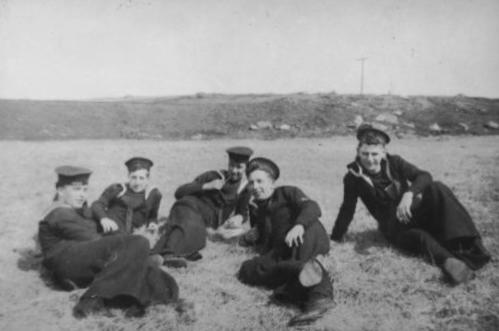
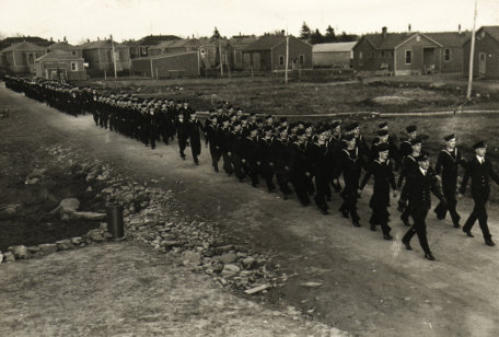
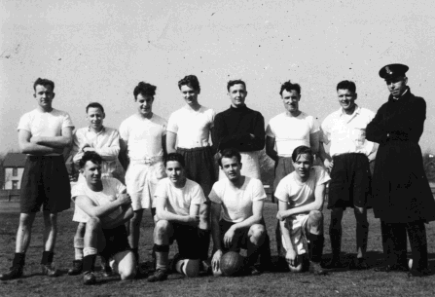


copyright © Wartime Heritage Association
Website hosting courtesy of Register.com - a web.com company
Wartime Heritage
ASSOCIATION
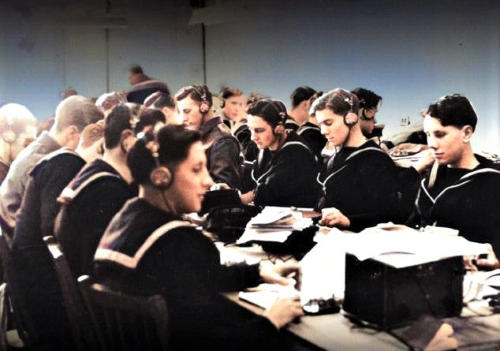
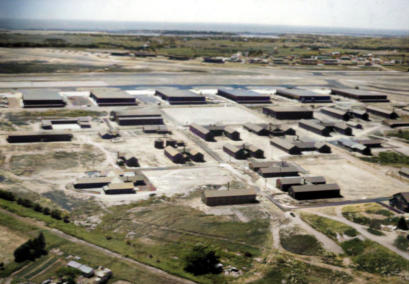
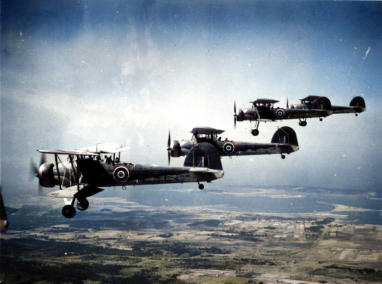
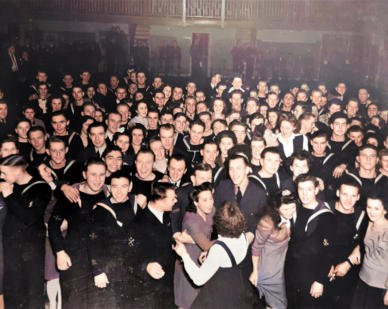
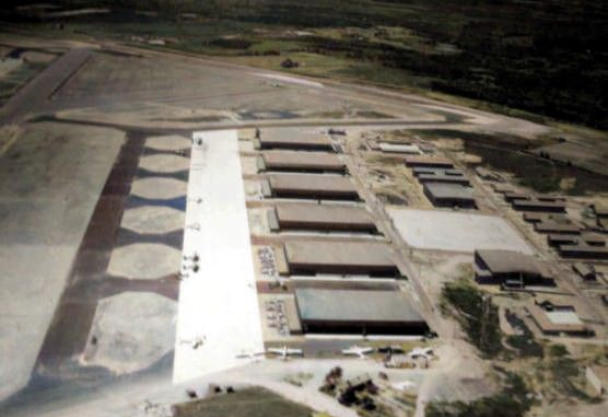


- World War I - Menu
- WWI Stories and Articles
- Photos - Yarmouth Soldiers
- Selection of World War I Songs
- WWI Casualties of Yarmouth, NS
- Those Who Served - Yarmouth, NS
- WWI Casualties Digby Co. NS
- WWI Casualties Shelburne Co. NS
- Merchant Mariners (1915) Yarmouth, NS
- Canadian Forestry Corps - Non Yarmouth Birth/Residence Enlistments
- US Draft Registry - Yarmouth NS Born


- World War II - Menu
- WWII Stories and Articles
- Telegraphist Air Gunners
- WWII Casualties of Nova Scotia
- US Casualties with NS Connection
- Far East/Pacific Casualties with NS Connection
- Merchant Navy Casualties Nova Scotia
- Nova Scotia WWII Casualties Holten Canadian War Cemetery
- D-Day Casualties - Nova Scotia
- CANLOAN Program Casualties - Nova Scotia
- Battle of the Bulge Casualties - Nova Scotia
- WWII Casualties Yarmouth NS
- Yarmouth Casualties - RCAF RAF Canadian Army WWII
- Yarmouth Co., Marrages WWII
- Casualties Non-Born/Residents with Connection to Yarmouth Co., Nova Scotia.
- WWII Casualties Digby Co., NS
- Non-Nova Scotian WWII Casualties Buried in Nova Scotia
- WWII RCAF Casualties Aged 16-18
- Brothers/Sisters Who Served - World War II
